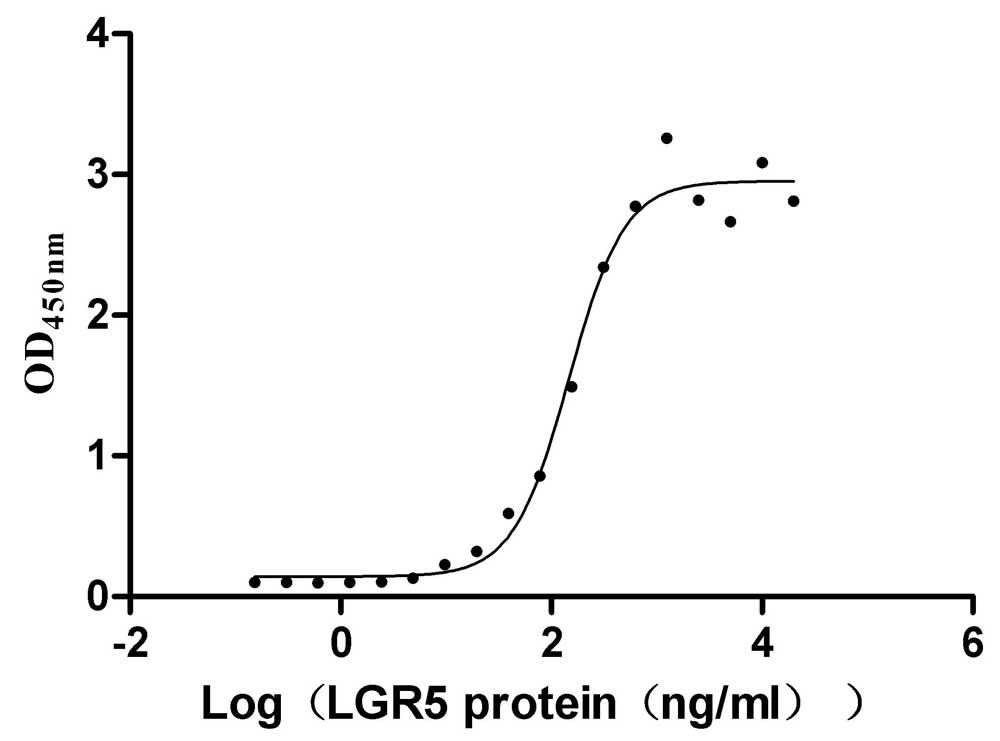Recombinant Mouse Histone acetyltransferase KAT2B (Kat2b), partial
-
中文名称:小鼠Kat2b重组蛋白
-
货号:CSB-YP867471MO
-
规格:
-
来源:Yeast
-
其他:
-
中文名称:小鼠Kat2b重组蛋白
-
货号:CSB-EP867471MO
-
规格:
-
来源:E.coli
-
其他:
-
中文名称:小鼠Kat2b重组蛋白
-
货号:CSB-EP867471MO-B
-
规格:
-
来源:E.coli
-
共轭:Avi-tag Biotinylated
E. coli biotin ligase (BirA) is highly specific in covalently attaching biotin to the 15 amino acid AviTag peptide. This recombinant protein was biotinylated in vivo by AviTag-BirA technology, which method is BriA catalyzes amide linkage between the biotin and the specific lysine of the AviTag.
-
其他:
-
中文名称:小鼠Kat2b重组蛋白
-
货号:CSB-BP867471MO
-
规格:
-
来源:Baculovirus
-
其他:
-
中文名称:小鼠Kat2b重组蛋白
-
货号:CSB-MP867471MO
-
规格:
-
来源:Mammalian cell
-
其他:
产品详情
-
纯度:>85% (SDS-PAGE)
-
基因名:
-
Uniprot No.:
-
别名:Kat2b; Pcaf; Histone acetyltransferase KAT2B; EC 2.3.1.48; Histone acetyltransferase PCAF; Histone acetylase PCAF; Lysine acetyltransferase 2B; P300/CBP-associated factor; P/CAF; Spermidine acetyltransferase KAT2B; EC 2.3.1.57
-
种属:Mus musculus (Mouse)
-
蛋白长度:Partial
-
蛋白标签:Tag type will be determined during the manufacturing process.
The tag type will be determined during production process. If you have specified tag type, please tell us and we will develop the specified tag preferentially. -
产品提供形式:Lyophilized powder
Note: We will preferentially ship the format that we have in stock, however, if you have any special requirement for the format, please remark your requirement when placing the order, we will prepare according to your demand. -
复溶:We recommend that this vial be briefly centrifuged prior to opening to bring the contents to the bottom. Please reconstitute protein in deionized sterile water to a concentration of 0.1-1.0 mg/mL.We recommend to add 5-50% of glycerol (final concentration) and aliquot for long-term storage at -20℃/-80℃. Our default final concentration of glycerol is 50%. Customers could use it as reference.
-
储存条件:Store at -20°C/-80°C upon receipt, aliquoting is necessary for mutiple use. Avoid repeated freeze-thaw cycles.
-
保质期:The shelf life is related to many factors, storage state, buffer ingredients, storage temperature and the stability of the protein itself.
Generally, the shelf life of liquid form is 6 months at -20°C/-80°C. The shelf life of lyophilized form is 12 months at -20°C/-80°C. -
货期:Delivery time may differ from different purchasing way or location, please kindly consult your local distributors for specific delivery time.Note: All of our proteins are default shipped with normal blue ice packs, if you request to ship with dry ice, please communicate with us in advance and extra fees will be charged.
-
注意事项:Repeated freezing and thawing is not recommended. Store working aliquots at 4°C for up to one week.
-
Datasheet :Please contact us to get it.
靶点详情
-
功能:Functions as a histone acetyltransferase (HAT) to promote transcriptional activation. Has significant histone acetyltransferase activity with core histones (H3 and H4), and also with nucleosome core particles. Also acetylates non-histone proteins, such as ACLY, PLK4, RRP9/U3-55K and TBX5. Acts as a circadian transcriptional coactivator which enhances the activity of the circadian transcriptional activators: NPAS2-ARNTL/BMAL1 and CLOCK-ARNTL/BMAL1 heterodimers. Involved in heart and limb development by mediating acetylation of TBX5, acetylation regulating nucleocytoplasmic shuttling of TBX5. Acts as a negative regulator of centrosome amplification by mediating acetylation of PLK4. Acetylates RRP9/U3-55K, a core subunit of the U3 snoRNP complex, impairing pre-rRNA processing. Also acetylates spermidine.
-
基因功能参考文献:
- histone H3K9 acetyltransferase PCAF plays a critical role in osteogenic differentiation of mesenchymal stem cells. PMID: 27300495
- These results uncover p300 as a direct target of mTORC1 and suggest that the mTORC1-p300 pathway plays a pivotal role in cell metabolism by coordinately controlling cell anabolism and catabolism PMID: 29033323
- The epigenetic factor PCAF regulates vascular inflammation and is essential for intimal hyperplasia development. PMID: 29016683
- This study demonstrated that pcaf increase in skeletal muscle in muscle atrophy. PMID: 26372908
- Treatment with a pan-acetylase inhibitor, anacardic acid, reduced the binding affinity of p300 and PCAF to the NKX2.5, beta-MHC, Cx43 promoters and attenuated H3K9 hyperacetylation. PMID: 25797917
- Gcn5 and PCAF repress IFN-beta production in an enzymatic activity-independent and non-transcriptional manner: by inhibiting the innate immune signaling kinase TBK1 in the cytoplasm. PMID: 25269644
- PCAF acetylates two lysine residues K328 and K450 in PGC-1alpha. PCAF in the obese mouse liver greatly represses gluconeogenic enzyme activation and glucose production and improves glucose homeostasis and insulin sensitivity. PMID: 25497092
- Study reveals that Gcn5/PCAF facilitate adipogenesis through regulation of PPARgamma expression and regulate brown adipogenesis by influencing Prdm16 expression. PMID: 25071153
- KLF10, functions as a toggle to integrate antagonistic signals regulating FOXP3 via Sin3-HDAC/PCAF pathway and, thus, immune activation. PMID: 24944246
- PCAF is necessary for axonal regeneration and also promotes regeneration after spinal cord injury. PMID: 24686445
- These data unveil a p53/PCAF/Gli1 circuitry centered on PCAF that limits Gli1-enhanced mitogenic and prosurvival response. PMID: 24013724
- PCAF is an important regulator for promoting osteoblast differentiation via acetylation modification of Runx2. PMID: 23468178
- CSB and PCAF play cooperative roles to establish the active state of rRNA genes by histone acetylation PMID: 23667505
- Depletion of KAT2B or WDR5 decreased gluconeogenic gene expression. PMID: 24051374
- PCAF acts as master switch in the inflammatory processes required for effective arteriogenesis. PMID: 23788761
- Polycomb antagonizes p300/CREB-binding protein-associated factor to silence FOXP3 in a Kruppel-like factor-dependent manner. PMID: 22896699
- Within the context of fear extinction, p300/CBP-associated factor functions as a transcriptional coactivator. PMID: 22933779
- p300 and PCAF cooperate in the control of microRNA 200c/141 transcription and epithelial characteristics PMID: 22384255
- downregulation of PCAF by TNF-alpha provides negative feedback regulation to inflammatory reactions in liver epithelial cells; upregulated microRNAs in TNF-alpha-treated cells, miR-181a/b (miR-181a and miR-181b) suppressed translation of PCAF mRNA PMID: 22219331
- One function of histone acetyltransferase p300 within the prefrontal cortex is to constrain synaptic plasticity, since it is required for the formation of fear extinction memory. PMID: 21593332
- low SIK2 activity was associated with increased p300 HAT activity, ChREBP hyperacetylation, and hepatic steatosis PMID: 21084751
- p53, TA-p73, and p300 binding and Foxo3 expression decrease during liver regeneration, and this suggests a critical growth control mechanism mediated by these transcription factors in vivo. PMID: 20564353
- Data demonstrate that ERRalpha interacts with and is acetylated by p300 coactivator associated factor (PCAF) in vitro and in mouse liver. PMID: 20484414
- We conclude that PCAF regulates the expression of proteins involved in Abeta generation and degradation, thus rendering PCAF KO insensitive to amyloid toxicity. PMID: 20219649
- FXR acetylation is normally dynamically regulated by p300 and SIRT1 but is constitutively elevated in metabolic disease states PMID: 19883617
- These results identified the KLF8 activation domain located between residues 101-260 where the well-conserved Q118 and Q248 are essential for recruiting p300 and PCAF to activate target gene transcription. PMID: 20107328
- Data demonstrate that Foxp3 is acetylated, and this can be reciprocally regulated by the histone acetyltransferase p300 and the histone deacetylase SIRT1. PMID: 19996091
- Overexpression and ribozyme-mediated targeting of transcriptional coactivators CREB-binding protein and p300 revealed their indispensable roles in adipocyte differentiation through the regulation of peroxisome proliferator-activated receptor gamma PMID: 11884404
- Direct involvement of CREB-binding protein/p300 in sequence-specific DNA binding of virus-activated interferon regulatory factor-3 holocomplex. PMID: 11940575
- co-activation of crystallin gene expression PMID: 11943779
- acetylation of AML1 through p300 is a critical manner of posttranslational modification and identify a novel mechanism for regulating the function of AML1 PMID: 14752096
- the stability of PCAF is regulated by MDM2 by its ubiquitination and degradation PMID: 14769800
- P/CAF and p300 have roles in acetylation-induced stabilization of E2F1 PMID: 15123636
- established that pCAF and p300 carry out sequential and functionally distinct events on a promoter leading to transcriptional activation in a MyoD-dependent in vitro transcription system PMID: 15289617
- Mdm2 (murine double minute 2), in the presence of active H-Ras or N-Ras, induces CBP/p300 degradation in NIH 3T3 cells PMID: 16704373
- p300 acetyltransferase activity is essential for maintaining self-tolerance of B lymphocytes. PMID: 17513743
- These observations demonstrate that PCAF histone acetylase is involved lifelong in the chromatin remodeling necessary for memory formation and response to stress. PMID: 17805310
- HDAC4 and PCAF bind to cardiac sarcomeres and play a role in regulating myofilament contractile activity. PMID: 18250163
- Contributes to Hox homeodomain gene regulation and is required for normal anteroposterior patterning of the mouse skeleton. PMID: 18430026
- Data show that p300/CBP-associated factor could increase the beta-catenin transcriptional activity, induce its nuclear translocation, and up-regulate its protein level by inhibiting its ubiquitination and improving its stability. PMID: 18987336
- P/CAF deacetylation by HDAC3 and in a minor degree by HDAC1, HDAC2, or HDAC4 leads to cytoplasmic accumulation of P/CAF. PMID: 19015268
显示更多
收起更多
-
亚细胞定位:Nucleus. Cytoplasm, cytoskeleton, microtubule organizing center, centrosome.
-
蛋白家族:Acetyltransferase family, GCN5 subfamily
-
数据库链接:
Most popular with customers
-
Recombinant Human Neuropilin-1 (NRP1) (Active)
Express system: Mammalian cell
Species: Homo sapiens (Human)
-
Recombinant Human Tumor necrosis factor ligand superfamily member 9 (TNFSF9), partial (Active)
Express system: Mammalian cell
Species: Homo sapiens (Human)
-
Recombinant Human HLA class II histocompatibility antigen gamma chain (CD74), partial (Active)
Express system: Mammalian cell
Species: Homo sapiens (Human)
-
Recombinant Human R-spondin-1 (RSPO1), partial (Active)
Express system: Mammalian cell
Species: Homo sapiens (Human)
-
Recombinant Macaca fascicularis Trophoblast glycoprotein (TPBG), partial (Active)
Express system: Mammalian cell
Species: Macaca fascicularis (Crab-eating macaque) (Cynomolgus monkey)
-
Recombinant Macaca fascicularis Cadherin 6(CDH6),partial (Active)
Express system: Mammalian cell
Species: Macaca fascicularis (Crab-eating macaque) (Cynomolgus monkey)




-AC1.jpg)












